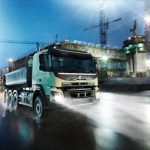Volkswagen Trolleybuses in São Paulo!

FRANK BEETON reports on environmentally friendly trolleybus activity in South America
In an era when numerous new driveline technologies are finding their way into public service vehicles, there is still a demand for the more traditional types that have been in existence for a century or more. After pioneering developments in Germany around the beginning of the 20th century, electric trolleybuses gained popularity as a more flexible alternative to the earlier trams (which ran on rails) and double-decker versions were to be found operating in many British and Commonwealth cities until the 1960s.
Thereafter, their popularity in that particular sphere of influence waned, mainly due to operational difficulties caused by their reliance on fixed overhead current supply infrastructure, and the increasing cost of operation.
Trolleybuses certainly did not disappear, however, and single-deckers, using the same basic technology, continued to operate in many parts of the world, particularly those regions where relatively cheap electricity was available. One of the areas where they remained in use was South America.
A recent report drew our attention to events in the Brazilian city of São Paulo, which had become home to ten new all-electric trolleybuses built on specially adapted MAN Volksbus 17.280 chassis. These low-floor units were equipped with an electric drive module and associated wiring harnesses supplied by Electra, of Porte Alegre, Rio Grande do Sul. These, were fitted at the rear in place of the usual diesel engine and gearbox.
The conversion process, developed over a period of six months, utilised Volksbus axles, with a specially selected rear differential ratio to suit the electric traction motor. These trolleybuses are now being operated in the city by Environmental Transport. The bodywork is built by Induscar, the manufacturer of Caio bodies. The chassis were processed initially by the bodybuilder, before moving on to Electra for installation of the electrical equipment.
MAN Latin America, which now owns the Brazilian Volkswagen truck and bus operation, has responded to customer requirements for environmentally friendly solutions by developing this product, and says that it intends to exploit this opportunity on a wider front.
In our opinion, this modern evolution of the traditional trolleybus concept is ideal for bus rapid transit applications, where dependence on an overhead power supply is no disadvantage, and buses travelling in reserved road space do not need to overtake each other.
The MAN Volksbus design appears relatively simple. It uses a large proportion of standard components, and avoids the complication of hybrid drive systems, auxiliary engines or individual wheel motors. In this respect, it appears to have considerable potential appeal in emerging markets, where basic technical support is readily available for the “host” chassis.
The main appeal of the basic trolleybus lies in the absence of heavy and expensive batteries, which are characteristic of hybrid and plug-in applications, and the simplicity of the overhead power supply, which does not include the application of below-the-road-surface induction technology or any other similar high-tech solution.
Published by
Focus on Transport
focusmagsa





 !
Starting 1 April, every
!
Starting 1 April, every


 FUSO: Driving the Future of Mobile Healthc
FUSO: Driving the Future of Mobile Healthc



 A brand
A brand




 Wondering about the maximum legal load for a
Wondering about the maximum legal load for a 
 The MAN hTGX powered by a hydrogen combus
The MAN hTGX powered by a hydrogen combus


 Exciting News for South African Operators
Exciting News for South African Operators



